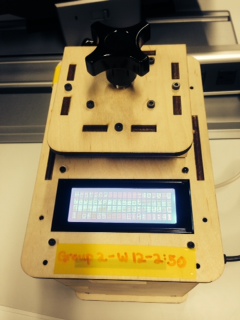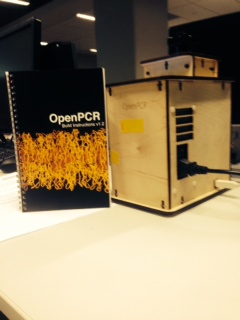BME100 f2013:W1200 Group2 L4
| Home People Lab Write-Up 1 | Lab Write-Up 2 | Lab Write-Up 3 Lab Write-Up 4 | Lab Write-Up 5 | Lab Write-Up 6 Course Logistics For Instructors Photos Wiki Editing Help | |||||||||
|
OUR TEAMLAB 1 WRITE-UPThe Original Design Part 3) When we unplugged the wires of the screen from the primary circuit board, the machine's screen went blank.
ProtocolsThermal Cycler Program
DNA Sample Set-up Procedure Materials: Procedure: Positive control: cancer Negative control: Not cancer Step 3: Add DNA/primer mix to positive control.
PCR Reaction Mix -Taq DNA Polmerase
Research and DevelopmentPCR - The Underlying Technology
The components of the PCR Reaction include the template DNA, primers, Taq Polymerase, Magnesium Chloride (MgCl2), and Deoxyribonucleotides (dNTP's). Each component or reagent is added to the PCR tube before running them through the PCR device and software called "Open PCR". The template DNA is the source of genetic information in which the enzyme taq polymerase copies the target sequence from. The Taq Polymerase is an enzyme that can withstand high temperatures, making it a thermostable enzyme that is ideal for use in the PCR reaction process. It reads the genetic information from the DNA template, proofreads, copies, and synthesizes new nucleotides to form a new strand that will pair with the 'parent' strand. Primers are pieces or fragments of DNA that attach to the a single-strand of DNA. There are two primers, the 3' primer and the 5' primer which both separately attach to an opposite end of a single strand. Without the primers, the Taq Polymerase cannot start adding nucleotides to the existing strand. Magnesium chloride (MgCl2) acts as the buffer of the reaction and also as a co-factor to the enzyme Taq Polymerase. Finally, the deoxyribonucleotides (dNTP's) are the building blocks of new strand of DNA. They are nucleotides in which the Taq Polymerase synthesizes new nucleotides to base pair with the existing ones of the parent strand.
Thermal cycling is the process of cycling a PCR tube alternatively in cold or hot temperatures in a matter of different specific times. Thermal cycling is of six steps in which includes the initial step, denature, anneal, extend, the final step, and the final hold. In the initial step, the PCR reaction is first exposed to a high temperature of 95 degrees celsius for 3 minutes. Taq polymerase is activated and begins to read the genetic data from DNA, proofreads, and copies the data or target sequence which it will eventually generate. In the second step denature, due to the fact that DNA is composed mostly of proteins, in high heat of 95 degrees Celsius for 30 seconds, proteins denature and start losing their tertiary structure which is the two-stranded structure. The two-stranded structure begins to uncoil and separates into two single-stranded structures of DNA. The next step called annealing is the process in which the contents of the PCR tube are exposed to a temperature of 57 degree Celsius for 30 seconds. During this process, and with the single strands, primers begin to attach opposite ends of a strand. The 3' primer attaches to the end of strand that contains the hydroxide group, while the 5' primer attaches to the end with the phosphate group. In the fourth step called extend, the process lasts for 30 seconds and exposed to 72 degrees Celsius. The Taq Polymerase is again activated and searches for primers that are attached to existing strands of nucleotides. Once it finds the primers, it will attach new units of nucleotides to the 3' end of the parent strand. Polymerase will not add new nucleotides to the 5' end primer and so the new growing strand will extend from one direction only. A new complimentary strand to the parent strand is now formed at the end of this process. The final step is a process wherein the PCR reaction is exposed to temperature of 72 degree celsius for 3 minutes, wherein during this time Taq Polymerase proofreads again, checks, and makes sure no mutation were formed and that each new nucleotide is bind correctly to the strand, and each new strand is fully extended. Lastly, the final hold is at 4 degree Celsius for an unknown or indefinite time, wherein no more reaction or activity of Taq Polymerase is made, this signifies the end of a reaction or cycle.
During annealing wherein Taq Polymerase synthesizes new nucleotides and attaches it to a growing strand, base pairings are made in such that an existing nucleotide is paired off with the new nucleotide. The nucleotide Adenine (A) is always paired with Thymine (T), the nucleotide Thymine (T)is always partnered with Adenine (A), Guanine (G) with Cytosine (C), and Cytosine (C) always with Guanine (G).
| |||||||||






